Book of Revelation Explained – Part 3
The Book of Revelation Explained – Part 3
 The Book of Revelation is a series of visions, seen and recorded by John, one of Jesus’ apostles. We saw in the last two issues how the book uses imagery to depict the history of the Roman Empire from its early phases through to its eventual fall. In this concluding article we find that history is now being viewed from a different perspective: a spiritual one.
The Book of Revelation is a series of visions, seen and recorded by John, one of Jesus’ apostles. We saw in the last two issues how the book uses imagery to depict the history of the Roman Empire from its early phases through to its eventual fall. In this concluding article we find that history is now being viewed from a different perspective: a spiritual one.
In the last ten chapters of the book, the reader sees everything working together towards the great climax of God’s purpose – the establishment of God’s Kingdom on earth.
The Seed of the Woman
In Revelation chapter 12, we catch up with events inside the church, and the picture is not encouraging. John sees a vision of a pregnant woman in heaven who gives birth to a son. There is a conflict with a large red dragon, which is thrown out of heaven. This unusual imagery is based on the first prophecy in the Bible – the promise to Adam and
Eve that a descendant of the woman would destroy the serpent which deceived them and led them to commit the first sin (Genesis 3:15).
led them to commit the first sin (Genesis 3:15).
That promise was fulfilled in the Lord Jesus, son of the virgin Mary, and therefore the seed of the woman, who defeated the power of sin in his death and resurrection. But that was long before and the Revelation now uses this Old Testament language to describe the fourth century battle between Constantine and the pagan emperor (Licinius) who ruled over the eastern third of the Empire. Paganism was overthrown and Christians could briefly rejoice that they could worship in peace, a short-term foretaste of the peace of God’s coming Kingdom.
Compromise and Corruption
But shadows lay ahead. The woman represents the church. She is no longer a virgin, pure and separate from the world, awaiting the return of the Lord as her husband–to–be (see 2 Corinthians 11:2). She is pregnant, unfaithful to him, and now in a position of power as a partner of emperors and princes. That is why in the vision she is depicted in heaven, and crowned with the sun and stars.
The effect of power was compromise and corruption; the true gospel of the First Century church was corrupted.
New teachings crept in from Greek philosophy, such as humans having immortal souls, and the myth that Jesus is God. A hierarchy of priests, bishops and archbishops replaced the simplicity of the early church. Christians once refused to fight in the Roman army, but now joined its ranks.
Persecution of True Believers
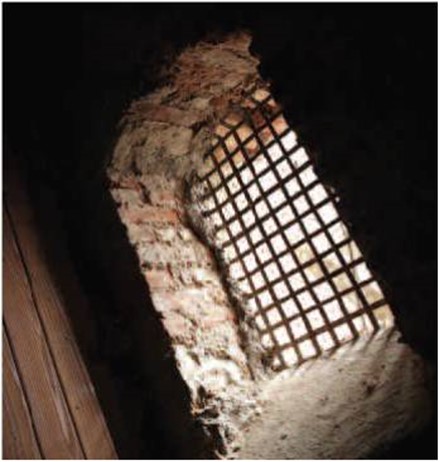 There were some who protested against this corruption. A tiny minority, they championed the true gospel as preached by the apostles, and they suffered in consequence. There is no intolerance like religious intolerance. As the centuries passed, they faced exclusion, imprisonment and death. The ousted pagan dragon is replaced in the next chapter by another composite beast, with seven heads, which has great power and we read:
There were some who protested against this corruption. A tiny minority, they championed the true gospel as preached by the apostles, and they suffered in consequence. There is no intolerance like religious intolerance. As the centuries passed, they faced exclusion, imprisonment and death. The ousted pagan dragon is replaced in the next chapter by another composite beast, with seven heads, which has great power and we read:
“And it was given unto him to make war with the saints, and to overcome them…” Revelation 13:7
The record goes on to describe harsh persecution – including captivity and execution – for true believers, really testing their faith and endurance.
More Beasts
Another beast appears, this time with two horns. It makes an image of the previous beast and forces people to worship it. It has the number 666.
What is all this about?
The different beasts are different phases of Rome’s religious development. The seven heads are explained for us in chapter 17, when we come to consider the last phase – a red beast ridden by a harlot.
The red beast still has the seven heads, and they are identified as a city of seven hills, ruling over the earth.
Rome was the political and religious power of the time, well fitting the various descriptions in the different phases. It was Rome that killed Christians when the pagan emperors reigned. When they were gone it was Catholic Rome, the new religion, which persecuted those faithful believers who protested against her.
Moving to the End
Chapters 14 and 15 comfort the true believers (called ‘saints’) with a picture of them with Jesus at the Day of Judgment, when their innocent blood will be avenged.
As we near the end of the story, the spotlight swings back to the secular world of politics, to see how this will be accomplished. In chapter 16, seven bowls are now poured in sequence onto the world. These are described as “the wrath of God”, a series of judgments on a world and a religious system that has persecuted God’s saints for too long.
These outpourings are setting the scene for the return of Jesus. And then he comes!
Like the thief in the night who catches us unprepared, he steals into the world:
“Behold, I am coming as a thief. Blessed is he who watches, and keeps his garments, lest he walk naked and they see his shame” (Revelation 16:15).
War!
The appearing of Jesus initiates the war of Armageddon, the climactic confrontation that runs through all the scriptures, when the united forces of the world set themselves against God and His son.
The outcome is clear: defeat for the opponents of God and the Lord Jesus. The battle is marked by an earthquake which shatters the world, and the coalition is destroyed by giant hailstones, like the enemies of Israel in Joshua chapter 10.
The religious conflict reaches its finale in chapters 17–18, where the adulterous harlot is thrown down into a fiery and fatal destruction.
In the meantime, Jesus’ faithful bride–to–be prepares herself for the marriage supper of the Lamb. This is a picture of the true body of believers getting ready for the Kingdom of God to begin.
A Glorious Conclusion
Through chapters 19–20 John observes amazing events, foretold throughout the Bible. In the vision, he witnesses the resurrection of the dead, and the day of judgment. The wicked are condemned to death, but the faithful are granted to live for ever and to reign on the earth with their Lord, with great rejoicing.
The final chapters of the Revelation paint a glorious picture of the new world, the Kingdom of God.
And I heard a loud voice from heaven saying, “Behold, the tabernacle of God is with men, and He will dwell with them, and they shall be His people. God Himself will be with them and be their God. And God will wipe away every tear from their eyes; there shall be no more death, nor sorrow, nor crying. There shall be no more pain, for the former things have passed away” (Revelation 21:3-4).
Ultimately, God will live with men in His holy city Jerusalem, and living waters will glide out of that capital city to bring healing and peace to all nations. We can read about this in Revelation 22:2.
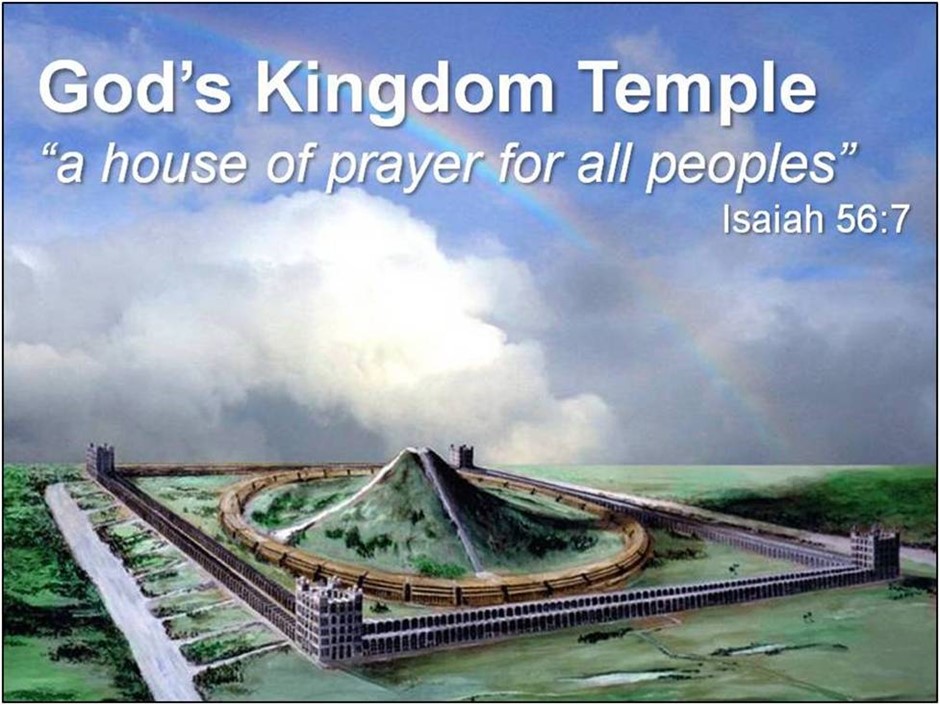
The good news, the Gospel, which flows through the whole of the Bible, is that we can be there. If we read and learn from the pages of the Bible, and we live faithfully watching for Jesus’ coming, then, in the beautiful words of Revelation 22:14, we will be given the right to eat of the tree of life and live forever.
By David M Pearce
See Book of Revelations Explained – Part 1
See Book of Revelations Explained – Part 2
See The Kingdom of God on Earth – What will it be like?
![]()

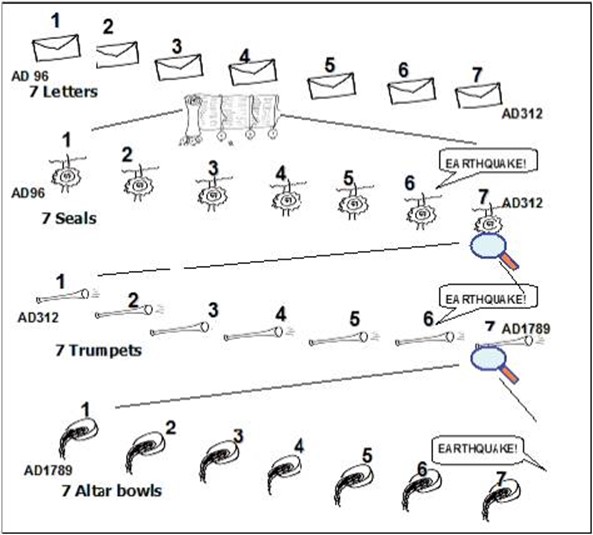 It is a surprise to find seven churches in the same area with such a variation in their spiritual health, from Ephesus – patiently enduring and bearing up for Jesus’ sake; to Laodicea – smug and complacent, but in Jesus’ view close to death (see Revelation 1:11 to 3:22).
It is a surprise to find seven churches in the same area with such a variation in their spiritual health, from Ephesus – patiently enduring and bearing up for Jesus’ sake; to Laodicea – smug and complacent, but in Jesus’ view close to death (see Revelation 1:11 to 3:22).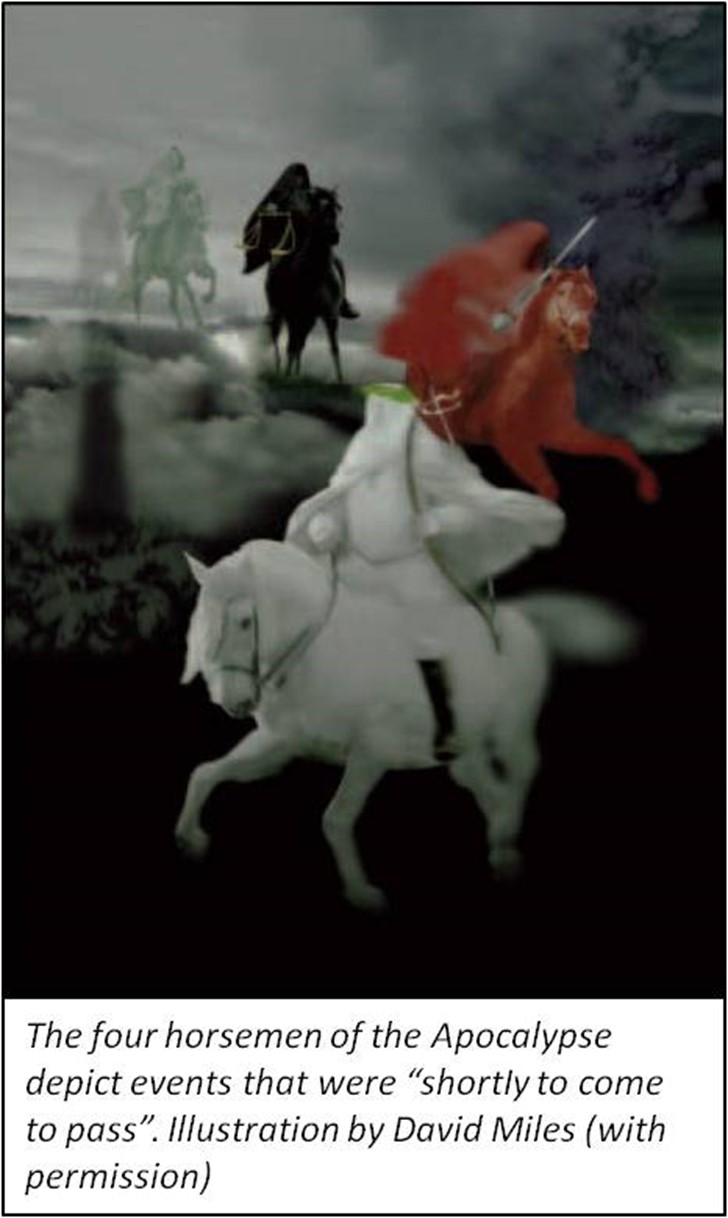 with a warrior on his back. The next seal introduces a red horse ridden by a man with a dagger.
with a warrior on his back. The next seal introduces a red horse ridden by a man with a dagger.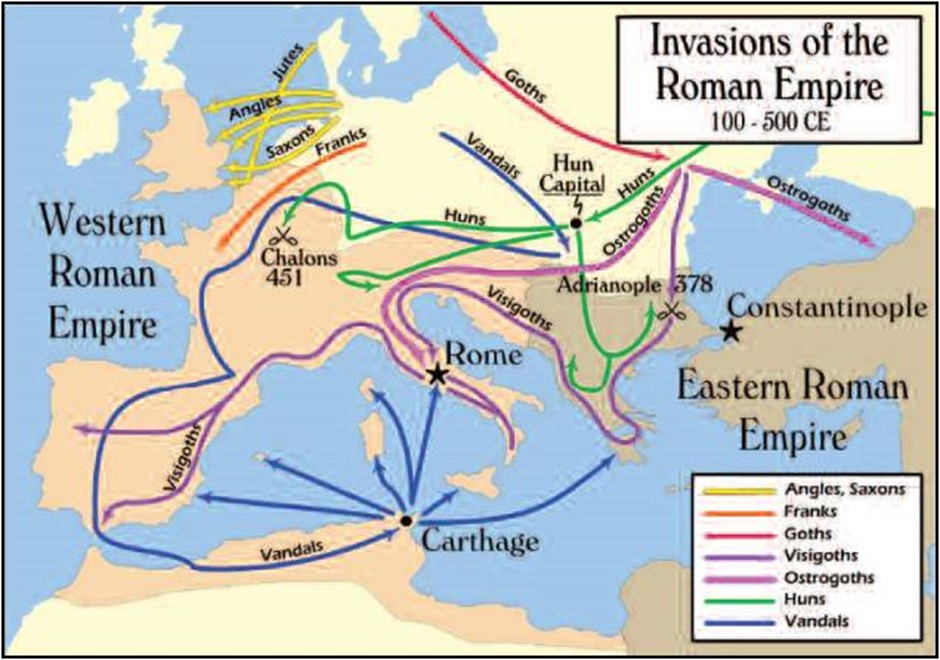
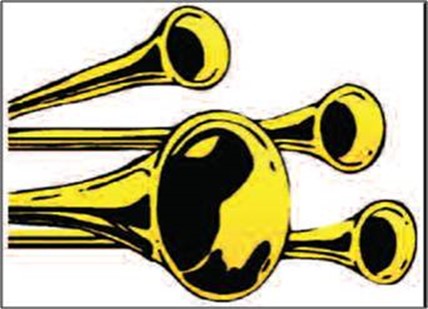 other, heralding the next stages in history as these barbarians attack:
other, heralding the next stages in history as these barbarians attack: